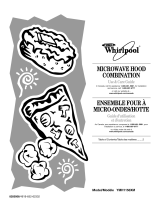
14
Microwave Cooking Power
Many recipes for microwave cooking specify which cooking power
to use by percent, name or number. For example,
70%=7=Medium-High.
Use the following chart as a general guide for the suggested
cooking power of specific foods.
MICROWAVE COOKING POWER CHART
NOTE: A percentage of 0% is also acceptable. This will not heat
up.
To Set a Cooking Power other than 100%:
1. Touch the number keypads to set a length of time to cook.
2. Touch COOK POWER.
3. Using the Microwave Cooking Power chart above, enter the
corresponding number for the desired power level.
4. Touch START.
The display will count down the cook time.
When the stop time is reached, the oven will shut off
automatically and the end screen will appear on the display.
If enabled, end-of-cycle tones will sound, then reminder tones
will sound every minute.
5. Touch CANCEL or open the door to clear the display and/or
stop reminder tones.
Doneness
Doneness is a function used for adjusting the cook time. This
feature is used on all sensor and non-sensor functions with the
exception of Manual Cooking, Popcorn, EasyConvect™, Custom
Reheat (beverage-manual), Defrost (manual) and Steam (manual).
The 3 Doneness levels are Normal (default), More or Less and will
appear once activated on the lower text line of the upper oven
display. Doneness can be changed only before starting the cycle.
To Change Doneness Setting:
After setting a function, the Doneness setting can be changed if
desired. This can be done before or after the “START?” prompt
appears in the display. Touch the COOK POWER keypad
repeatedly to toggle through Doneness options of Normal, More or
Less.
Sensor Cook
The Sensor Cook function is used in Reheat (meal), Steam
Cooking and Popcorn.
During the Sensor Cook function a sensor automatically adjusts for
the cook time and power level.
The microwave oven display will show the “Maximum Time
Remaining” prompt and the time countdown once the sensor
identifies the cooking duration.
If the microwave oven door is opened during a sensor function, the
microwave oven will turn off, and any additional operations will be
canceled.
For best cooking performance:
Before using a sensor cook function, make sure power has been
supplied to the microwave oven for at least 2 minutes, the room
temperature is not above 95°F (35°C), and the outside of the
cooking container and the microwave oven cavity are dry.
Manual Cooking
To Use:
1. Touch COOK TIME and then number keypads to set a length
of time to cook.
OR
Touch the number keypads to set a length of time to cook. To
use this feature, the display must be in the time of day
visualization. Time can be set up to 99 minutes and 99 seconds.
If using 100% cook power, skip to Step 3.
2. Touch COOK POWER, and then enter the desired power
level. See the Microwave Cooking Power Chart in the
“Microwave Cooking Power” section.
NOTE: Doneness function is not active for manual cooking.
3. Touch START/ADD 1 MINUTE.
The display will count down the cook time.
Touching Start/Add 1 Minute while the microwave oven is
operating will add cook time to the current cycle by 1 minute.
Multiple minutes can be added by repeatedly touching
Start/Add 1 Minute.
When the stop time is reached, the oven will shut off
automatically and “Cooking Complete” will appear on the oven
display.
If enabled, end-of-cycle tones will sound, and then reminder
tones will sound every minute.
4. Touch CANCEL or open the door to clear the display and/or
stop reminder tones.
PERCENT/NAME NUMBER USE
100%, High
(default setting)
10 Quick heating convenience
foods and foods with high
water content, such as soups,
beverages and most
vegetables.
90% 9 Cooking small, tender pieces
of meat, ground meat, poultry
pieces and fish fillets.
Heating cream soups.
80% 8 Heating rice, pasta or
casseroles.
Cooking and heating foods
that need a cook power lower
than high. For example, whole
fish and meat loaf.
70%,
Medium-High
7 Reheating a single serving of
food.
60% 6 Cooking sensitive foods such
as cheese and egg dishes,
pudding and custards.
Cooking non-stirrable
casseroles, such as lasagna.
50%, Medium 5 Cooking ham, whole poultry
and pot roasts.
Simmering stews.
40% 4 Melting chocolate.
Heating bread, rolls and
pastries.
30%, Medium-
Low, Defrost
3 Defrosting bread, fish, meats,
poultry and precooked foods.
20% 2 Softening butter, cheese, and
ice cream.
10%, Low 1 Taking chill out of fruit.




















